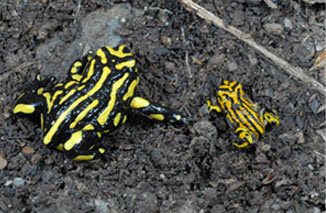The Corroboree Frog Recovery Program is working to ensure future generations will be able to see live Corroboree Frogs in captivity and so the species continue to play a role in the high altitude wetland ecosystems of the Australian Alps.
Several zoos now have robust captive populations of these species and work is being done to develop techniques to maintain populations of these species in the wild. While our ability to reduce the impact of the amphibian chytrid fungus is limited at this stage, there is every reason to believe that a solution to this problem is not far away.
There is much to learn about how some Northern Corroboree Frog populations have maintained greater abundance, or how other frog species have been able to recover after chytrid fungus has led to declines and range contractions.
The amphibian chytrid fungus is a global problem and we can expect to learn much from the many research programs occurring around the world.
The Corroboree Frog Recovery Program also contributes valuable knowledge to similar programs around the world. While we cannot predict how new technologies in the future will assist the recovery of Corroboree Frogs – there have certainly been amazing discoveries in recent time that could not have been imagined 50 years ago.
We are confident that through dedication and collaboration we can ensure Corroboree Frogs remain an important part of Australia’s biodiversity and culture for generations to come.

Adult and juvenille Corroboree Frogs

